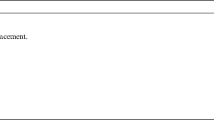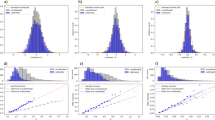Summary
Bootstrap samples with noise are shown to be an effective smoothness and capacity control technique for training feed-forward networks and for other statistical methods such as generalized additive models. It is shown that noisy bootstrap performs best in conjunction with weight decay regularisation and ensemble averaging. The two-spiral problem, a highly nonlinear noise-free data, is used to demonstrate these findings.
Access this chapter
Tax calculation will be finalised at checkout
Purchases are for personal use only
Preview
Unable to display preview. Download preview PDF.
Similar content being viewed by others
References
E. Baum and K. Lang. Constructing hidden units using examples and queries. In R. P. Lippmann, J. E. Moody, and D. S. Touretzky, editors, Advances in Neural Information Processing Systems, volume 3, pages 904–910. Morgan Kaufmann, San Mateo, CA, 1991.
C. M. Bishop. Training with noise is equivalent to Tikhonov regularization. Neural Computation, 7 (1): 108–116, 1995.
L. Breiman. Bagging predictors. Machine Learning, 24: 123–140, 1996.
J. Buckheit and D. L. Donoho. Improved linear discrimination using time-frequency dictionaries. Technical Report, Stanford University, 1995.
G. Deffuant. An algorithm for building regularized piecewise linear discrimination surfaces: The perceptron membrane. Neural Computation, 7 (2): 380–398, 1995.
B. Efron and R. Tibshirani. An Introduction to the Bootstrap. Chapman and Hall, New York, 1993.
S. E. Fahlman. Faster-learning variations on back-propagation: An empirical study. In T. J. Sejnowski, G. E. Hinton, and D. S. Touretzky, editors, Connectionist Models Summer School. Morgan Kaufmann, San Mateo, CA, 1988.
S. E. Fahlman and C. Lebiere. The cascade-correlation learning architecture. CMU-CS-90–100, Carnegie Mellon University, 1990.
R. A. Fisher. The use of multiple measurements in taxonomic problems. Annals of Eugenics, 7: 179–188, 1936.
S. Geman, E. Bienenstock, and R. Doursat. Neural networks and the bias-variance dilemma. Neural Computation, 4: 1–58, 1992.
L. K. Hansen and P. Salamon. Neural networks ensembles. IEEE Transactions on Pattern Analysis and Machine Intelligence, 12: 993–1001, 1990.
T. Hastie and R. Tibshirani. Generalized additive models. Statistical Science, 1: 297–318, 1986.
A. Krogh and J. A. Hertz. A simple weight decay can improve generalization. In J.E. Moody, S.J Hanson, and R.P. Lippmann, editors, Advances in Neural Information Processing Systems, volume 4, pages 950–957. Morgan Kaufmann, San Mateo, CA, 1992.
K. J. Lang and M. J. Witbrock. Learning to tell two spirals apart. In D. S. Touretzky, J. L. Ellman, T. J. Sejnowski, and G. E. Hinton, editors, Proceedings of the 1988 Connectionists Models, pages 52–59. 1988.
U. Naftaly, N. Intrator, and D. Horn. Optimal ensemble averaging of neural networks. Network, 8 (3): 283–296, 1997.
M. P. Perrone. Improving Regression Estimation: Averaging Methods for Variance Reduction with Extensions to General Convex Measure Optimization. PhD thesis, Brown University, Institute for Brain and Neural Systems, May 1993.
Y. Raviv and N. Intrator. Bootstrapping with noise: Application to time-series prediction. Preprint.
Y. Raviv and N. Intrator. Bootstrapping with noise: An effective regularization technique. Connection Science, Special issue on Combining Estimators, 8: 356–372, 1996.
B. D. Ripley. Pattern Recognition and Neural Networks. Oxford Press, 1996.
J. Sietsma and R. J. F. Dow. Creating artificial neural networks that generalize. Neural Networks, 4: 67–79, 1991.
D. H. Wolpert. Stacked generalization. Neural Networks, 5: 241–259, 1992.
Author information
Authors and Affiliations
Editor information
Editors and Affiliations
Rights and permissions
Copyright information
© 1999 Springer-Verlag London Limited
About this chapter
Cite this chapter
Sharkey, A.J.C. (1999). Variance Reduction via Noise and Bias Constraints. In: Sharkey, A.J.C. (eds) Combining Artificial Neural Nets. Perspectives in Neural Computing. Springer, London. https://doi.org/10.1007/978-1-4471-0793-4_7
Download citation
DOI: https://doi.org/10.1007/978-1-4471-0793-4_7
Publisher Name: Springer, London
Print ISBN: 978-1-85233-004-0
Online ISBN: 978-1-4471-0793-4
eBook Packages: Springer Book Archive




